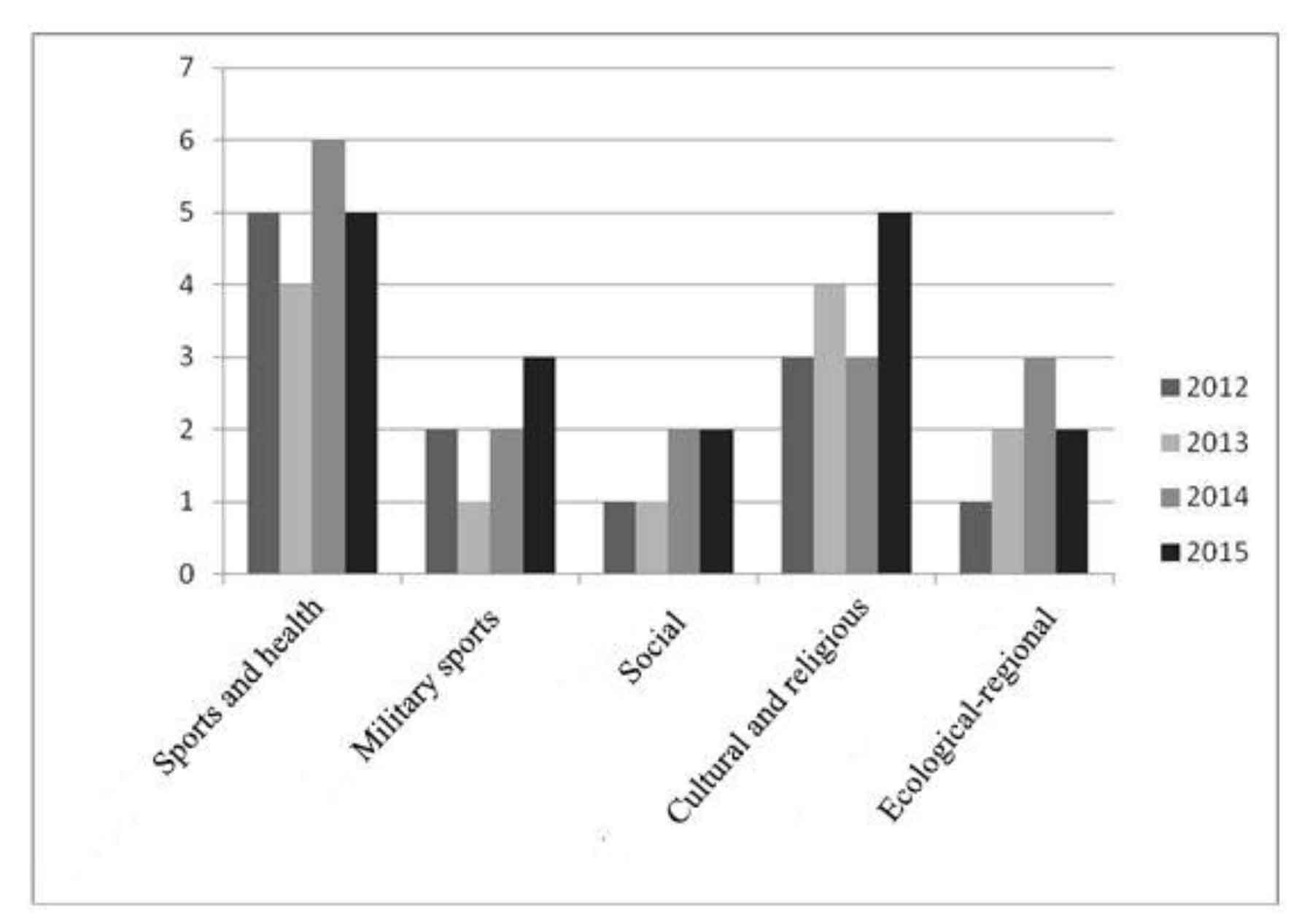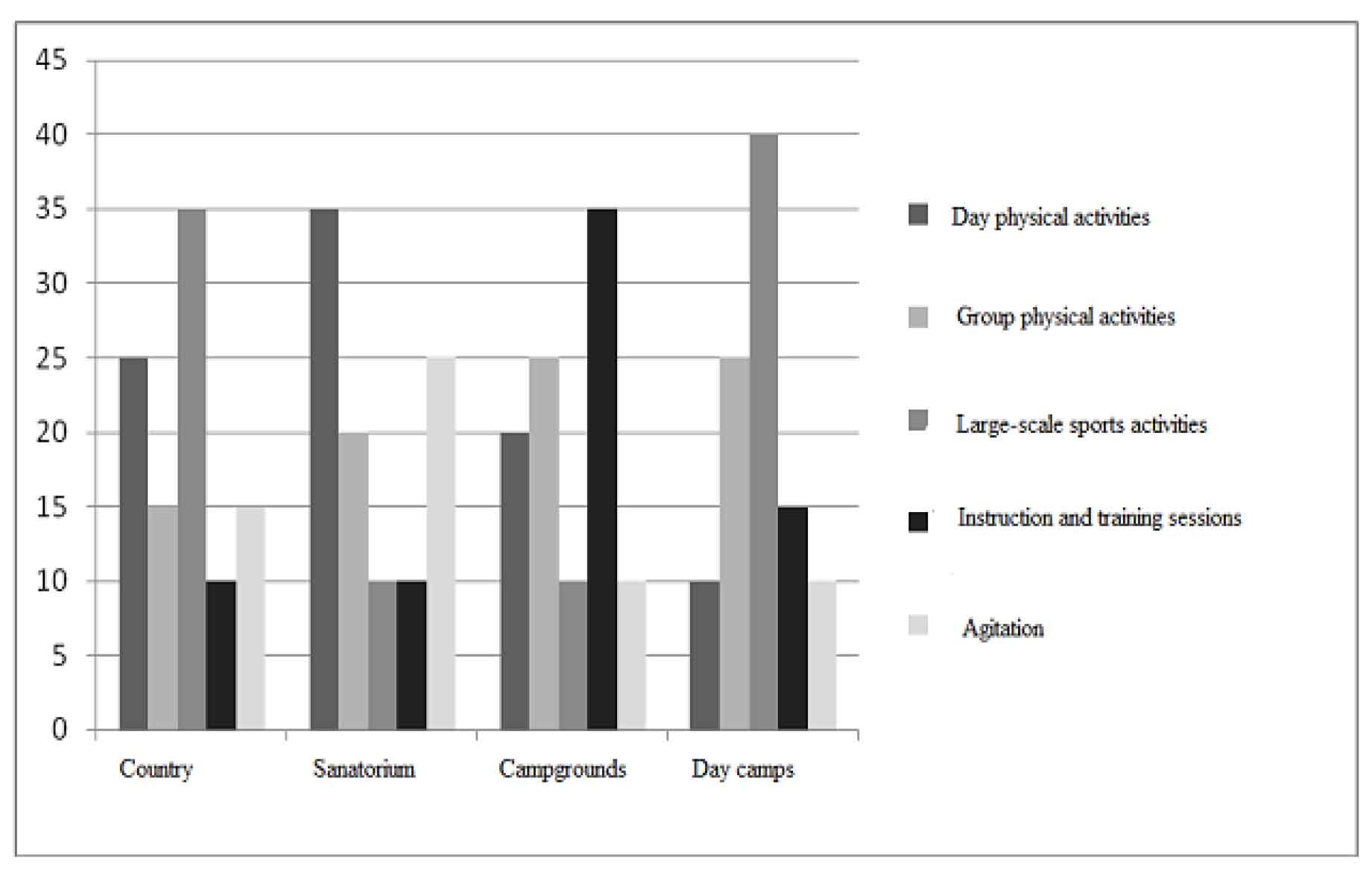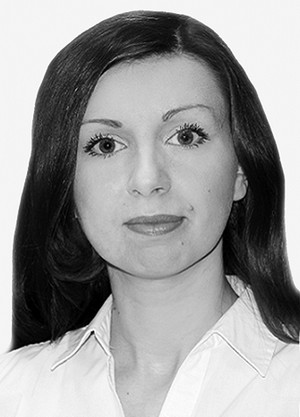Specificity of health and fitness programs in children and youth tourism
Фотографии:
ˑ:
J.A. Karvunis1
Professor, Dr.Med. L.V. Kapilevich1, 2
1National Research Tomsk State University, Tomsk
2National Research Tomsk Polytechnic University, Tomsk
Keywords: youth tourism, health and fitness activities, recreation.
Introduction. Children and youth tourism (CYT) traditionally belongs to the most socially significant forms of tourism. Its development level can serve as one of the indicators of social well-being of the region, its focus on the younger generation [1]. The key factors contributing to the development of modern CYT are the variety of recreational programs, innovative methods of organization of leisure activities, promotion of sport and healthy lifestyle, price advantages compared to health resorts [2]. First of all, tourism is the way to recover from physical and mental stress due to the change of activities. Trips, even the shortest, influence the development of such personal qualities of a child as sociability and self-discipline. Tourism as a form of physical activity is one of the most effective recreational technologies, contributing to the formation of healthy lifestyle of a man and society [5].
Objective of the study was to investigate the structure of health and fitness activity in the context of children and youth tourism and to identify the value of its sports and recreational component through the example of the Tomsk region.
Materials and methods. The study has been conducted during the period of May to October 2015. The detailed analysis of “Register of organizations of children’s leisure and recreation”, provided by the Department of Children and Family issues of the Tomsk region, was carried out. The register comprises the data on existing recreational organizations of all business and property forms located within the territory of the Tomsk region. In addition, we held a questionnaire of 60 employees of children and youth recreational establishments, who worked during the 2015 summer season, - 15 people in each camp category. Respondents were suggested to answer a number of questions related to the specificity of organization of health and fitness activities, among other things it was required to rank the value of various activities relying on the acquired experience. It was suggested to distribute the total sum of 100 % in percentage correlation between 5 categories of forms of health and fitness activities focusing on the value of factor and amount of time given for its implementation in the recreation structure.
Results and discussion. In recent years there have been elaborated and implemented various programs in the Tomsk region, that closely correlate summer holidays with the realization of the state policy in the field of children’s welfare, patriotic, moral and spiritual education of children, prevention of juvenile delinquency. The region observes improvement of the quality of services provided in the camps. In total, during the period of recreation campaign of 2015 the region had 605 functioning children recreational organizations of all types, 92,2% or 558 of which – day camps, 22 stationary country recreational organizations and 8 of sanatorium type, 17 tourist and campgrounds [4]. Fig. 1 shows the structure of distribution of areas of specialized camps in the Tomsk region and its dynamics for the last 4 years. It can be concluded, that the most widely featured areas of children’s recreation in the campgrounds are sport and health and cultural (in some cases religious). The value and quantity of military sport camps are increasing. Social campgrounds are arranged comprising the work with special children and families who are in difficult straits.
Physical education in health camp has specific features, conditioned by relatively short-term staying in the camp, varied age contingent of children, health condition, level of physical development and physical fitness. These characteristics should be considered when organizing health and fitness, sport and large-scale events. Physical education work in the camp should contribute to the formation in children of moral and volitional qualities, patriotism, awareness of the value of healthy lifestyle.
In the course of the study, a research on relative distribution of forms of health and fitness activities within the structure of summer recreation of children and youth has been conducted. Questionnaire results of employees of specialized institutions enabled us to reveal the specifics of organization of this type of activity in various camps (Fig.2).
Examples are the campgrounds in the territory of the Tomsk region: on the bank of the Ket river in the Verkhneketsky district (“Spartanets” of Beloyarsk school № 1), on the Tugoyakovka river in the Tomsk region (“Gorizont, Ekolog”), on the Kiya river in the Zyryansky district (“Tayozhny kray” of Zyryansky children’s home). If visiting tourist area is one of the objectives of tourism, the base of campgrounds is actually chosen in the tourist regions of Russia. For instance, the Tutal’sk cliffs in the Kemerovo region (“Gornaya shkola”, “SibEkstrem”), the Sea of Japan in the Far East, Iyussk nature park with the caves in Khakassia (“Zov”), Issyk-Kul lake in Central Asia, the Katun river, the Katun and North-Chuysk ridges of the Altai Mountains, Eastern coast of the lake Baikal in Transbaikal, the Ob-Tomsk interfluve in the Tomsk region.
Conclusions.
1. At the present stage of development of children and youth tourism in Russia (in the Tomsk region in particular), one can distinguish both positive and negative trends. The first include economic independence, diversification of camp and shift areas, innovations in methods of organization of forms of recreation; among negative factors are – the lack of competent personnel and coordinated system of implementation of activities, failure to comply with government regulations and requirements, project-financing-related issues [3].
2. Based on the analysis of specifics and organizational structure of children health camps and studying the organizational system of active leisure and physical education of children, we can conclude that this form of recreation promotes physical development of children and satisfaction of child's personal needs in the cognitive, recreational, and communicative areas.

Fig.1. The structure of areas of specialized campgrounds

Fig.2. The structure of priorities of forms of sports and health activities in various types of camps
Abstract
At the present stage of development of children and youth tourism one can distinguish both positive (economic independence, diversification of camp and shift areas, innovations in methods of organization of forms of recreation) and negative (lack of competent personnel, failure to comply with government regulations and requirements, project-financing-related issues) trends. Children and youth tourism as a form of recreation promotes physical development of children and satisfaction of child's personal needs in the cognitive, recreational, and communicative areas.
References
- Aktivnye vidy turizma (Active forms of tourism [electronic resource]: - Available at: http:// www.rusadventures.ru /-2013.
- Zagorodny letniy lager': 1-11-e klassy (Country summer camp: 1st-11th grades) / S.I. Lobacheva, V.A. Velikorodnaya, K.V. Shchigol'. – Moscow: Vako, 2006. – 207 P.
- Kalashnikova T.V. Ekonomika rossiyskogo sporta: vyzovy i protivorechiya (Economy of Russian sport: challenges and contradictions) / T.V. Kalashnikova, T.S. Selevich, I.V. Krakovetskaya, N.N. Ilysheva, N.E. Danilova // Teoriya i praktika fiz. kultury. – 2015. – № 8. – P. 43–45.
- Karvunis J.A. Sostoyanie i perspektivy razvitiya aktivnogo turizma v molodezhnoy srede (State and development prospects of active tourism among youth) / J.A. Karvunis, L.V. Kapilevich // Teoriya i praktika fiz. kultury. – 2014. – № 10. – P. 62–64.
- Karvunis J.A. Aktivny turizm kak perspektivnaya forma rekreatsii studencheskoy molodezhi v kanikulyarny period (Active tourism as a promising form of recreation of students during holidays) / J.A. Karvunis, L.V. Kapilevich // Teoriya i praktika fiz. kultury. – 2015, – № 11. – P. 47–48.




 Журнал "THEORY AND PRACTICE
Журнал "THEORY AND PRACTICE